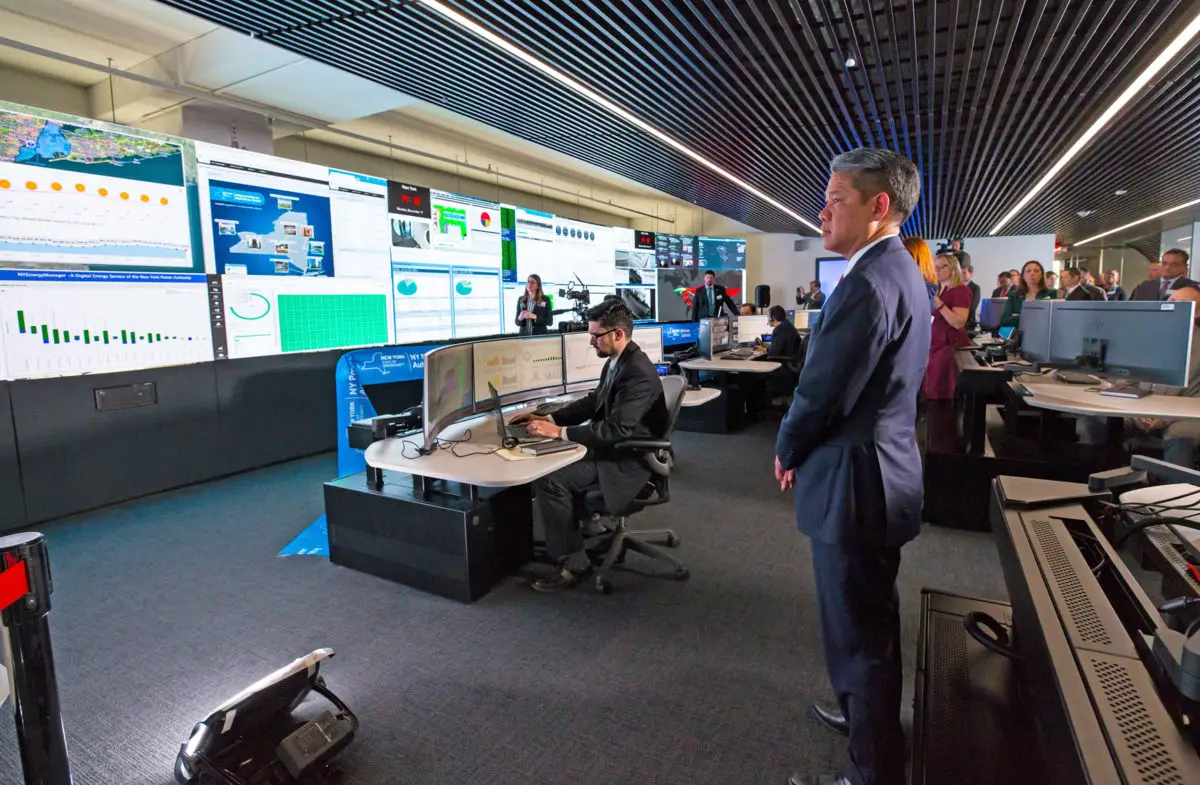NYPA operations center to monitor 24,000 sensors to track digitized grid

The New York Power Authority (NYPA) recently unveiled its Integrated Smart Operations Center, or iSOC, in White Plains, a $4 million project that turns part of the eighth floor of NYPA headquarters into a mission control center to monitor its 16 power plants and 1,400 miles of transmission lines.
At a Dec. 11 launch celebration, New York Power Authority CEO Gil C. Quiniones told a group of about 100 employees, public officials and utility executives that the ceremony represented “the start of our journey to becoming the first end-to-end digital utility, not just in the United States, in the world.”
Headquartered at 123 Main St., NYPA is already the largest state-owned utility in the country. It provides low-cost electricity to government entities, not-for-profit organizations, community-owned electric systems and electric cooperatives and some businesses. Its 16 power plants include two massive hydroelectric plants upstate on the Niagara and St. Lawrence rivers.
A digitized grid would allow NYPA to save potentially billions of dollars by identifying issues in its grid and power plants before they cause outages or rack up unexpected maintenance costs. Using predictive analytics software developed in partnership with General Electric Co., NYPA can monitor its grid and power plant assets through 24,000 strategically placed sensors.
That monitoring will be done from the 6,000-square-foot command center that is the centerpiece of the new 25,000-square-foot iSOC. There NYPA engineers will view a video wall, 9 feet high and 81 feet wide, that displays a seemingly endless amount of data and charts monitoring the utility’s assets. From the command center, NYPA can react to issues flagged by its analytics software.
“We”™re turning that data into actionable information,” said Richard Gaines, director of iSOC. “Insights, trends. We”™re watching for changes that would indicate there may be a problem down the road.”
Those data points come from the many parts that make up NYPA’s grid and power plants, including routers, switches, servers, turbine temperature sensors and load sensors on transmission lines. “All of those things are going into applications that monitor their health and alert us if there is something we need to take a look at,” Gaines told the Business Journal.
He referred to the alerts as “bad actor identification.”
“We can”™t possibly have enough people to watch all of these things individually, so what the systems do is watch them,” Gaines said. “The systems know what normal is and the systems tell us when there is an unacceptable deviation from normal.”
That could mean physical issues in the systems or cybersecurity issues, such as a potential hack.
Beyond security and maintenance, NYPA can also use the digitization to provide savings for customers. Through its separate New York Energy Manager program, which provides data on energy use to customers, NYPA has about 20,000 buildings and campuses it can monitor to suggest ways to save on electricity costs by cutting use.
“We”™re the first utility that”™s putting asset management, the customer”™s energy use, physical security and cybersecurity and network operations all in the same place,” Gaines said.
By going fully digital, Quiniones said NYPA can react to a “decentralization” in the way electricity is delivered. “This power grid that we have today, one-way power flow from large power plants, transmission, distribution to customers, is really being disrupted,” he said.
In reaction to that, the state has launched Reforming the Energy Vision, or REV, a long-term energy strategy backed by Gov. Andrew Cuomo. A central goal of that plan is for New York to generate half its electricity from renewable sources by 2030.
In a statement following the ceremony, Cuomo called the launch of iSOC a major milestone in the REV plan. New York”™s so-called “energy czar,” state Chairman of Energy and Finance Richard Kauffman, said at the event that “utilities need to catch up to the digital revolution that”™s been going on around us for a while.”
Digitizing the grid can help prepare for the absorption of distributed sources of energy, such as solar, and energy storage, he said.
“By partnering with the private sector, as with GE, NYPA is showing how we can move rapidly from the grid of yesterday to the grid of the future,” Kauffman said.
Built in five months, the NYPA center includes a 5,000-square-foot lobby work space with tall windows and a café that has a ceiling overhang designed to look like a hydropower turbine. The floor is also home to NYPA”™s Advanced Grid Innovation Laboratory for Energy, a supercomputer capable of modeling and simulating the electric grid for research. The facility also includes NYPA’s emergency operations center and an “innovation zone” of open-concept work space.
About 70 NYPA employees will work from the Integrated Smart Operations Center once fully occupied.
Quiniones tied the goal of achieving the first fully digital utility in New York to other electricity milestones in the state’s history.
“In 1882, Thomas Edison built the first power plant along Pearl Street in Lower Manhattan, and a few years after, Nikola Tesla invented how to transmit electricity long distance from Niagara Falls to Buffalo,” he said. “So we are steeped in that heritage of being the place where this greatest invention, the power grid, started. And today, and in years forward, join us in taking this current grid that we have into the digital, integrated network of the future.”